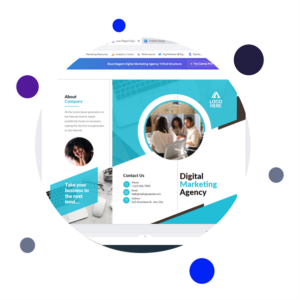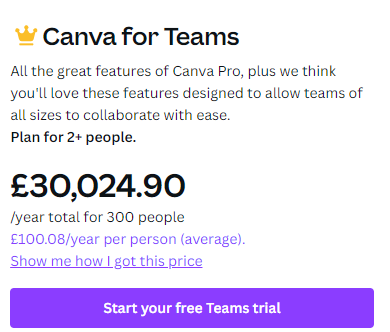
When Canva can't: why you need a Canva alternative for your team
There’s no denying that Canva is a great design tool for those who aren’t experts. It’s used by millions of people every month. Using it, anyone can create designs easily, even with limited skills or experience.
However, the strengths of Canva are also its weaknesses. These most come to light when using it in a team. Your users might feel confident in their designs, thanks to the Canva effect, but it doesn’t mean they’re on-brand.
And if your teams aren’t aligned, you’re facing inconsistent branding and confusing marketing materials. It endangers your brand reputation, which has knock-on effects to credibility and trust.
We explore why Canva isn’t the best option for teams and the alternative you should consider.
Why does brand consistency matter?
First things first: why does consistency matter across teams?
Brand consistency helps your organisation establish a strong, recognisable identity. With this, you can connect with customers and stakeholders.
When brand elements, such as logos, colours, fonts, tone of voice and messages align across your touchpoints, it builds trust, familiarity and loyalty.
Take infamous brands like Nike, McDonald’s and Apple. You can spot their marketing a mile off. They’ve also got massive, loyal customer bases. It’s all about brand equity – which only comes from consistency.
If teams aren’t using your brand in the same way across comms, it affects the way customers feel about your brand. You come across as unprofessional and unreliable. It’s also harder to build the right experience for your audience and encourage them to build positive connections. This undermines your sales potential.
When empowering your teams to design brand assets, you need to make sure they’re consistently following your guidelines. This is often where Canva falls short, with limited brand control for large teams and organisations.
The limitations of Canva for your team
1. No locking down of elements
As we’ve already mentioned, Canva makes design easy. There’s a range of elements to choose from to add into your designs. Users have free reign to move things about and place them where they see fit.
That’s great news for an individual with a specific artistic vision. It’s not so good for trying to keep teams on brand.
If you have a paid Canva for Teams account, you can lock some elements into place, like logos. But, even if elements are locked, users can still change the colours or place unwanted elements on top of them.
It doesn’t give you total control, which could lead to messy, off-brand designs. Though it offers a starting point for your users, they still have plenty of room for error.
2. Limited font and colour palettes
If you have a paid Canva account, there is the choice to add brand colour palettes and fonts. Your team can see these and choose to use them in their templates.
These tend to be limited to a set amount of colours and fonts you can add, which won’t be suitable for brands that need many.
There also isn’t any control over how people use those colours and fonts. For example, if there’s a preferred background colour, users aren’t tied to that. Again, it leaves risk of off-brand mistakes.
3. Limited customisation
Canva’s features are not specific to your brand. You can’t turn them on and off dependent on your needs, which may lead to chaos. Let’s look at an example.
One benefit of Canva is the large library of illustrations, stock images and graphics. Users can insert these into their designs as they like. This library is the same across every account. Though, non-paying users will have a significantly reduced selection.
Although these graphics are often high-quality, they aren’t all brand suitable.
If you’ve built an identity, it’s likely you have a specific style you want to embody with your designs. With so much choice, users are likely to pick something that’s not on brand.
So, you get mismatched output that doesn’t match your brand guidelines.
4. Do-it-yourself templates
Canva offers templates that keep your users on brand. Certain elements are pre-determined so users don’t stray too far from the lines.
However, you will need to build these yourself. Canva has some general templates, but these won’t be tailored to your brand.
It means you’ll need to invest time and effort into creating all the templates your organisation needs. For many busy marketing and brand managers, this isn’t ideal.
If you haven’t created templates before, the set up can be tricky. It can also delay things, when your users are ready to get going.
If you want someone to do the build for you, you’ll need to find a Canva alternative.
5. Pay-per-seat pricing
Canva has a free version, which is likely part of the reason it’s become so widely used. But there are limited options with it. To access all its features and content, you need to pay.
Canva for Teams is a paid option for (you guessed it) teams. It’s priced per seat. The first five users are included in the price, but after this you’ll be charged for every user you add on.

For large organisations that have many people generating brand materials, this is expensive. Your options are to limit your users or pay the price.
Neither of these are ideal for managing costs or capacity. You’re left with less people able to design (which harms your branch reach and productivity) or a huge cost to cover.
6. No centralised asset library
Canva doesn’t house a centralised asset library like many BAMs and DAMs do. It means you and your users won’t have access to your brand imagery unless someone takes the time to upload them manually.
Images also aren’t sorted into categories (though there is a search function). Users may struggle to find exactly what they need. This could lead them to one of the many off-brand stock images in the platform instead.
There also isn’t the ability to manage previously uploaded images for version control. This could lead to users featuring things they shouldn’t.
7. No integration
In the world of hybrid working, there’s a million websites and apps we use for work. Bringing them together is crucial for easy navigation and seamless experiences.
Unfortunately, Canva doesn’t offer much integration. It does have single sign-on but that’s about it. It doesn’t offer API or integration with your other tools, including your Intranet.
So, it’s yet another website you need to get your team to bookmark.
8. Tone of voice not included
Tone of voice is as crucial to brand as the visuals. While Canva is dedicated to how your brand assets look, it doesn’t offer anything to govern the words used.
People have the freedom to add text which may not reflect your brand voice or key messages. Even if the final design looks good, it won’t succeed if it doesn’t speak to the audience in the right way.
The only safeguard Canva offers is approvals (if you have a paid account). Even then, it’s up to you to read through every design and make suggestions. This isn’t great for boosting productivity or helping users do it for themselves.
9. Customer service
It’s always good to have someone to speak to when you need it. But with Canva, there’s limited customer service.
Paid users have access to 24/7 digital support, but this is used for raising technical issues or asking questions.
There isn’t hands-on guidance during the sales and onboarding process. You also won’t have a dedicated account manager or regular contact.
It means it’s harder to get the most out of the product and get the support your team needs to excel. You’ll have to do a lot of the leg work onboarding the platform into your organisation.
RightMarket: a Canva alternative
If you’re a marketing or brand manager, you might have already experienced Canva headaches. So, what’s the alternative?
Brand management solutions usually offer a better, tailored experience. If you’re looking for one that also makes it easy for anyone to create great designs, look no further than RightMarket.

RightMarket brings your teams and brand together. User-friendly features mean everyone in your organisation can create assets, regardless of experience.
Your brand guidelines are embodied in templates customised for your organisation. Everything that needs to be is locked down. Users only have access to approved imagery, fonts, colours and logos for total brand control.
Our Tone of Voice Assistant monitors language used and suggests better alternatives to off-brand terms. There’s no risk of anybody going wrong. Everyone creates great designs that protect your brand and connect with customers.
We also offer unlimited users (with no added cost when new team members join) so anyone who needs to have access can.
Everything is set up for you so you’re ready to go. We build your templates, based on your requirements, so you haven’t got to learn new software.

Plus, you’ll receive dedicated customer support through the onboarding process and beyond.
You’ll have everything you need to empower your teams to design, while staying on brand and growing your organisation’s reach.
Book a demo today
Find out how we can provide a Canva alternative that saves you from brand chaos.
